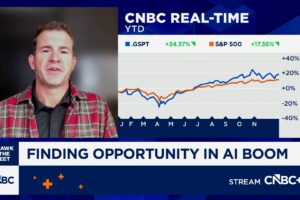We recently compiled a list of the 13 Best American Tech Stocks To Buy According to Short Sellers. In this article, we are going to take a look at where NVIDIA Corporation (NASDAQ:NVDA) stands against the other American tech stocks.
Tech stocks have outperformed the stock market for several years and account for over 30% of the market’s overall holdings. With market values estimated at trillions of dollars, the majority of the lauded Magnificent Seven stocks are American tech companies that are still expanding. Technology is constantly evolving, and investors have a lot of opportunities because of this ongoing advancement.
This dynamic progress was reflected in the US stock market when it rose more than 3% in the second quarter of 2024. In terms of the trade in artificial intelligence, technology companies remained at the top, and this trend did not appear to be slowing down throughout the quarter. The largest companies have outperformed the market this year, which has been a remarkable trend. The 500 largest companies’ large-cap market saw gains of 4.4% in Q2 YoY, increasing its 2024 return to above 15%. In contrast, the small-cap market saw a 3.3% drop, translating into a 1.6% 2024 return.
Even though technology companies outperformed in Q2 FY2024, Main Street Research’s James Demmert cautions investors not to treat all of them the same. Instead, they should prioritize those tech firms that can deliver consistent earnings, especially in an uncertain economy.
Investors should also stay informed about the 2024 tech industry statistics. According to the Information Technology and Innovation Foundation, almost one-third of the growth in the US economy is attributed to the IT sector, which is the main driver of the country’s economy. Similarly, the United States accounts for one-third of the world’s information technology market, according to the International Trade Administration, making it the largest tech market in the world. Computer and IT jobs reported a median annual wage of $104,420 in May 2023, while 108,503 college graduates with bachelor’s degrees in computer and information sciences graduated in 2022, a 3.5% increase YoY. The average yearly salary for tech majors is $90,000.
According to a report, tech trends in 2023 were dominated by electrification/renewables and generative AI. Internet searches for generative AI increased by 700%, and the area received significant funding as huge language models processed more data and expanded modalities. Even while global IT investment declined, electrification and renewables continued to draw large amounts of capital. These industries continue to have a high volume of job postings, signifying potential for long-term growth.
Looking forward, according to the Deloitte 2024 technology industry outlook, in the wake of current macroeconomic headwinds such as high inflation and supply chain disruptions, the technology industry confronts a cautious 2024 recovery. As per Deloitte’s Q4 2023 study, 62% of tech executives believe the industry is “healthy,” with growth anticipated in the areas of cybersecurity, cloud computing, and artificial intelligence. By late 2024, generative AI is expected to have a major impact on enterprise software and elevate operational efficiency. Tech companies and startups are investing more in AI, but enterprise adoption is still sluggish. However, this is predicted to change in the second half of 2024. Market expansion is anticipated to be propelled by enterprise expenditure on AI and IT services. Nonetheless, regulations in the EU and the US focusing on data privacy, sustainability, and AI ethics continue to provide challenges, forcing companies to follow regulations while leveraging these for competitive advantage. To reduce geopolitical risks and guarantee uninterrupted growth, supply networks will need to strategically change, and effective operations will need to be prioritized.
Methodology:
We sifted through holdings of tech ETFs and online rankings to form an initial list of 25 American tech stocks. Then we selected the 13 stocks that had the lowest percentage of their shares shorted. The stocks are ranked in ascending order of the lowest percentage of their shares shorted.
Why are we interested in the stocks that hedge funds pile into? The reason is simple: our research has shown that we can outperform the market by imitating the top stock picks of the best hedge funds. Our quarterly newsletter’s strategy selects 14 small-cap and large-cap stocks every quarter and has returned 275% since May 2014, beating its benchmark by 150 percentage points. (see more details here)

A close-up of a colorful high-end graphics card being plugged in to a gaming computer.
NVIDIA Corporation (NASDAQ:NVDA)
% of shares shorted: 1.20%
Industry-leading parallel processing is provided by NVIDIA Corporation (NASDAQ:NVDA)’s GPUs, which were formerly required for PC gaming applications but are now also needed for cryptocurrency mining, artificial intelligence, and possibly other applications.
The company’s dominant position in the market for graphics processing units, or GPUs, and the hardware and software tools required to support the rapidly expanding artificial intelligence business gives it a competitive advantage. Eventually, analysts predict that the largest tech companies will work to identify alternatives to NVDA or internal resources to broaden their AI offerings. However, these initiatives will probably erode rather than completely replace Nvidia’s leadership in this field, as it is the leading AI chip vendor.
The American tech firm has recently released NIM Agent Blueprints, an AI workflow catalog that can be customized and used by enterprise developers to build and implement generative AI systems.
Nvidia revealed second-quarter 2025 earnings and a third-quarter outlook that exceeded FactSet consensus predictions, demonstrating that the company is still operating at full capacity. The unending demand for graphics processing units, or GPUs, and associated goods used in data centers to power artificial intelligence has kept Morningstar analysts optimistic about Nvidia. Nonetheless, the firm’s earnings beat wasn’t as spectacular as it has been in previous quarters, which is why the shares declined after hours.
Citing solid Q2 2025 performance and ongoing high demand from significant areas like Hyperscalers, Enterprises, and Sovereign nations, Philip Woo of Phillip Securities reaffirmed a Buy rating on NVIDIA Corporation (NASDAQ:NVDA) with a $155 target. Nvidia’s dominance in AI GPUs and a promising outlook for 2025 and 2026 lend credence to his optimism.
The AI chip maker behemoth has hedge fund sentiments of 179 in Q2 2024. Ken Griffin’s Citadel Investment Group is the largest shareholder in the company, with 2,501,400 shares worth $3.85 million.
Overall NVDA ranks 8th on our list of the best American tech stocks to buy according to short sellers. While we acknowledge the potential of NVDA as an investment, our conviction lies in the belief that some AI stocks hold greater promise for delivering higher returns, and doing so within a shorter time frame. If you are looking for an AI stock that is more promising than NVDA but that trades at less than 5 times its earnings, check out our report about the cheapest AI stock.
READ NEXT: $30 Trillion Opportunity: 15 Best Humanoid Robot Stocks to Buy According to Morgan Stanley and Jim Cramer Says NVIDIA ‘Has Become A Wasteland’.
Disclosure: None. This article is originally published at Insider Monkey.






